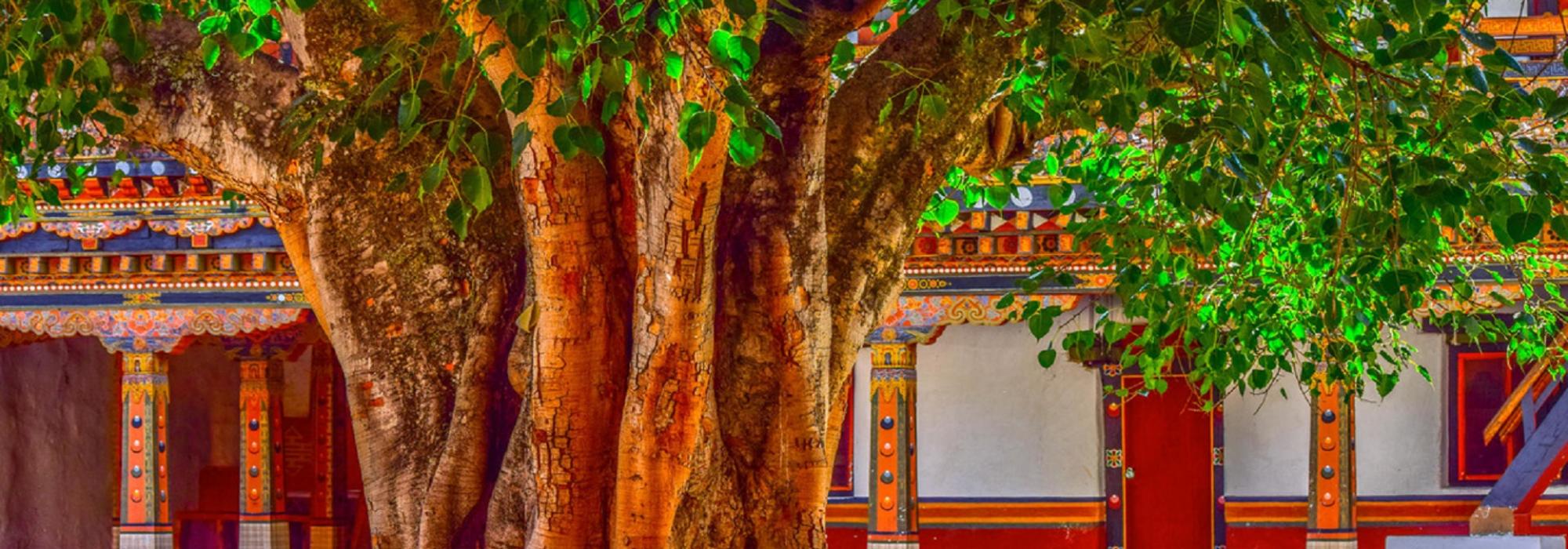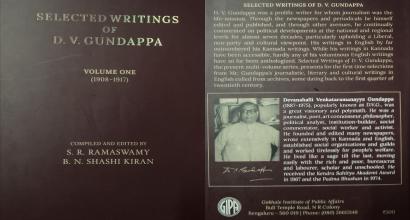Plague
The Plague pandemic came to Mulbagal perhaps after all other places in the vicinity. When the news spread that Plague had broken out in Kolar and Bowring Town, people of Mulbagal mused: “To the West of our town is Virūpākṣi Māramma. Nācāramma stands guard atop the hills. Raṇabheramma is at the centre of the town. And in the East Āñjaneyasvāmi stands tall with his mighty arm raised, protecting us vigilantly. When we are so protected on all sides, who or what can cause us harm?” Thinking thus, they emboldened each other.
Preventive Measures
To the same extent as a person puts on a façade of fearlessness, he is sure to be filled with fear on the inside. Our ancestors were no strangers to such fear.
They devised a few preventive measures:
- Drawing three nāmas[1] in big red stripes on all doors of the house – on the main door and on the doors of the kitchen, hall, and pūjā room. A red stripe in the middle drawn with red earth and two white stripes on either side of it drawn with lime. Turmeric and vermillion all around. Plague Mārī will run for her life upon seeing it.
- Writing Āstika in big bold letters on every door. Plague Mārī will flee upon reading the sage’s name.
- Bhajans in every house. Since it is difficult to organize bhajans every day in every house, it can be done in one house per street by turns.
- Lighting lamps in Āñjaneyasvāmi temple while singing bhajans.
Literary Compositions
Caught in the excitement of bhajans, our people composed many songs. The vaiśya community particularly participated in this with great enthusiasm. They had their own Bhajan Association in the town. This was their favourite song:
Kodaṃḍarāma Kodaṃḍarāma
Kodaṃḍarāma pāhi Kodaṃḍarāma
mā daṃḍaṃ mīku mī daṃḍaṃ māku
Kodaṃḍarāma pāhi Kodaṃḍarāma
Paṭṭābhirāma Paṭṭābhirāma
ghaṭṭīga pādaṃ paṭṭitirā
Kodaṃḍarāma! Kodaṃḍarāma!
Kodaṃḍarāma! Protect me, O Kodaṃḍarāma!
My prostration to you; your prostration to me
Kodaṃḍarāma! Protect me, O Kodaṃḍarāma!
Paṭṭābhirāma! Paṭṭābhirāma!
I clasp your feet firmly!
As a response to this, another group came up with a song:
Śeru pāluku śeru nīḻḻu kaliśenamma
rūpāyku rūpāyi dorikānamma
I have mixed one seru of water with one seru of milk
O Mother, I have got my money’s worth – rupee to rupee!
In this way, people got along by creating humour amid fear.
Every Tuesday, groups of people singing these bhajans visited a village called Virūpākṣi, which was two or three miles away from Mulbagal. The temple of Mārī in that village was like any other temple – a modest maṃṭapa. But it was ancient. It had walls on all four sides and a door at the front. The vigraha was a stone pillar decorated with a glistening brass mask. Heaps of flowers, turmeric, vermillion – these were present as in all places of worship in our country. A unique ritual marked out the place. It was called Uṭḻu and took place during the rathotsava[2].
Uṭḻu
Imagine a long stone pillar with a wooden frame and an iron wedge on top. A hole is carved beneath the wedge, in the middle of the frame’s lower surface. The wooden frame is hung to a metal bar through the hole. Four ropes are suspended from the frame. A person standing about fifteen feet away from the pillar on the ground holds a rope tied around one corner of the frame and revolves. The frame revolves with him. The sooner he goes around in a circle, the sooner the frame spins. As this happens, the ropes suspended from the frame start to revolve. Devotees tie four coconuts to the lower ends of these four ropes. As the coconuts revolve, three to four people holding up sticks stand below. The coconuts crash into these sticks, break, and fall as pieces. The devotees receive these coconut chunks as prasāda (consecrated food).
The village folk considered this a veritable source of entertainment. A proverb developed around broken coconut pieces: taṃṭe māḍidare tale ūṭḻu hoḍisibiṭṭenu – “Beware, if you cause any mischief, I’ll break your head in Uṭḻu!” Tamaṭès were beaten and a row of tambiṭṭu lamps was lit during this ritual. Accompanying this was Callamudda. It was conducted every Tuesday and Friday in those houses with children and ailing patients. People considered steaming rice spread as a dam on a plantain leaf, with curd in the middle and speckled with turmeric and vermillion, as an image of Māramma or Gaṅgamma. They offered this rice to the idol in the temple with great devotion. Ritual rice used to gather as a mini mount before the temple in Virūpākṣi village. All this happened half a century ago.
Nācāramma
Nācāramma seems to be the Tamil word for Mahālakṣmī: nācchiyār. Nācāramma’s temple is in a cave at the bottom of the Mulbagal Hill, in the south-eastern direction. The cave is engulfed by darkness. Nācāramma’s vigraha is on the wall at the back of the cave. A couple of maṃṭapas are at the front. People usually offer lamps of tambiṭṭu to Nācāramma. Here, too, rituals and utsavas are conducted frequently.
Raṇabheramma
Raṇabheramma’s temple is at the centre of the town. It is a modest structure. A stone pillar standing in a corner, which is about eight feet tall, is the vigraha. The pillar has four square faces atop which a round slopy surface is carved. One of the devotees had offered a mukhavāḍa[3] to the deity.
Raṇabheramma’s glory is immense. An abhiṣeka[4] of turmeric is offered to her on every Tuesday and Friday. Since the temple was close to our school, we left our classroom to our teachers and went to the temple to witness the abhiṣeka. Olagas (a single-reed wind instrument) were played during Raṇabheramma’s worship. We sang along:
Hāhā hūhū Raṇabheri!
Hūhū hāhā Raṇabheri!
Hoho hūhū Raṇabheri!
Hūhū hoho Raṇabheri!
Raṇabherī! Raṇabherī!
This was all our lyrics. The musicians played and we sang and sang and sang. We used to sit on walls to watch the spectacle.
Daivāveśa
The pinnacle of our excitement was in watching daivāveśa. It usually happens like this: A person starts shaking his arms. His hands and legs then begin to tremble violently. After a while, he falls to the ground with a thud. A couple of people around lift him and the arcaka (a person who performs ritualistic worship in a temple) sprinkles sanctified water on his head, puts a garland of flowers around his neck, and splashes generous fistfuls of turmeric and vermillion. The person then stands before the deity, flailing his arms and legs. Maṅgalārati (ritualistic offering of light) is offered in plenty. Devotees offer buttermilk and various juices. The person standing before the deity consumes a little of everything. Everyone is scared. An unfound fear grips the air. Then a couple of bold men approach him and ask: “Who are you? What do you want?”
The reply: “Don’t you know me? I’m your Mother! I protect you all! Where is my trident?”
Sisters
The arcaka brings the trident placed beside the deity’s vigraha and gives it. This person holds the trident and takes off. Groups of devotees and musicians run behind him. He passes through the village and enters the hill. By the time he reaches Nācāramma’s temple, his legs usually give way, and he falls on the ground. This is considered as the deity Raṇabheramma prostrating before her sister Nācāramma. This way, the younger sister unites with her elder sister.
Trident
A lemon is pierced on top of each of the blades of the trident. I have seen the trident very well. It is decorated with turmeric, vermillion, and flowers. It was a normal one initially. As time passed, it assumed monstrous proportions: Six-foot wide; six-foot high; three forks in each of the blades, which were themselves forked into three. It was like a huge iron screen of creepers. Either Rāyappācār or Puṭrasvāmācār from Mulbagal produced it. The trident could only be lifted by a well-built man if he mustered all his strength and used both hands. We were all wonderstruck by seeing the person with daivāveśa run holding this heavy trident, considering it Raṇabheramma’s symbol and weapon. The situation in our town was like this when Plague first broke out.
Rathotsava
During the Vaiśākha month (April / May) Śrīrāma-rathotsava was organized in Āñjaneyasvāmi temple in Mulbagal. Kodaṇḍarāma-rathotsava was during the month of Phālguna (February / March). And there was Viṭṭhaleśvara-rathotsava. These brought immense joy and excitement. Among them, Āñjaneya-rathotsava was the biggest. A huge fair usually set off during it. I have seen groups of people from neighbouring villages perform kolāṭa[5] as a part of the fair. By these, it is clear that our people were happy and enthusiastic. Someśvara-rathotsava was organized on a few occasions with great pomp. The ancient Someśvara temple was reinvigorated when Mokshagundam Venkatesayya was the amaldar (revenue officer). He took an active interest in the restoration of the temple’s puṣkariṇī (temple tank).
Venkatesayya
Mokshagundam Venkatesayya was Dewan Visvesvaraya’s cousin brother. He was tall, well built, and slightly dark – a person pleasing to see. He sported a lush moustache. His personality was commanding and taste, refined.
I have a special reason to remember him with gratitude. Once, when I was a high-school student, he called me to his side. After a few words he said: “I have a book you should read. I will give it to you. Read it and tell me what you think.”
The book he gave me was Plato’s The Trial and Death of Socrates. If my memory serves me right, a person by name Church translated it into English from the original Greek. This book was not translated into Kannada at the time. I read Plato’s dialogues in the book Mr. Venkatesayya gave me. I read them even today. It would be incorrect to call it mere reading – it is pārāyaṇa; I study the text reverentially. It is a work that oils the lamp of man’s inner light. Mr. Venkatesayya had identified its profundity.
Rāvaṇa’s Vehicle
Mr. Venkatesayya began a celebration of Rāvaṇa’s vāhana. Rāvaṇa’s idol was bigger than a fully grown human. It had ten heads, ten kirīṭas (headdress), twenty arms, twenty arm-ornaments, and other organs with their accessory ornaments. Behind this idol made of mud was a wooden structure. A wooden pedestal about eight-foot wide and twelve-foot high formed the base. One can only imagine the weight of all this mud and wood! About a hundred people gathered to carry it. High above this vāhana—about a house high—there was Pārvatī and Someśvara’s utsava-mūrtis (idols of these deities carried around in procession). I don’t think it is difficult for readers to imagine the complexity and commotion inherent in a hundred people hoisting these idols on to their shoulders, placing them on solid sticks, and carrying them around cramped lanes. The excitement was of such a high level that it overshadowed extraordinary difficulties. Since Venkatesayya was a person of immense pride, courage, and capability, this festival was successfully organized for many years.
[1] Religious sign worn on the forehead.
[2] The ratha (temple chariot) is a replica of the temple. It is richly decorated along with the utsava-mūrti (processional image) and taken round the important streets of the town. It is halted in certain specified places so that the common people can offer their worship almost at their doorstep. The ratha is drawn by the devotees, no distinction being made of caste or creed. [Ref: Concise Encyclopaedia of Hinduism.]
[3] A metal mask in the shape of the deity’s face.
[4] Offering consecrated water, milk, curds, honey, sugar, and fruits, turmeric, vermillion, etc. to the deity.
[5] A dance performed by a group of people by striking short sticks rhythmically to a song.
This is the thirteenth essay in the seventh volume of DVG’s Jñāpaka-citra-śālè, titled Namma Ūrina Grāma-devatègaḻu.
Concluded.









































